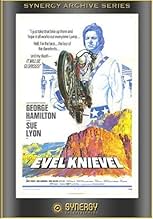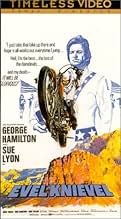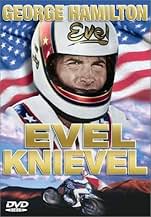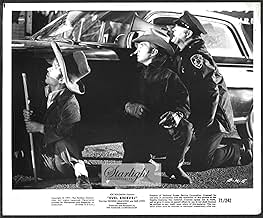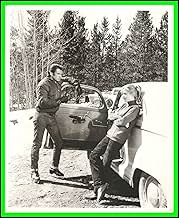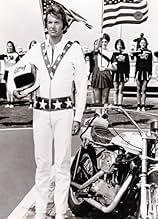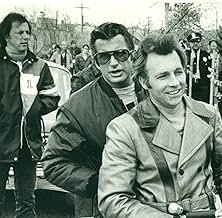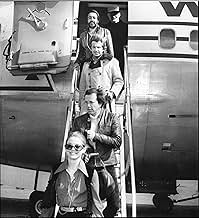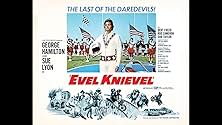IMDb-BEWERTUNG
5,2/10
1079
IHRE BEWERTUNG
Füge eine Handlung in deiner Sprache hinzuBiography of the famed motorcycle daredevil, much of which was filmed in his home town of Butte, Montana. The film depicts Knievel reflecting on major events in his life just before a big ju... Alles lesenBiography of the famed motorcycle daredevil, much of which was filmed in his home town of Butte, Montana. The film depicts Knievel reflecting on major events in his life just before a big jump.Biography of the famed motorcycle daredevil, much of which was filmed in his home town of Butte, Montana. The film depicts Knievel reflecting on major events in his life just before a big jump.
Alana Stewart
- Nurse #1
- (as Alana Collins-Hamilton)
Lee de Broux
- Wrangler #1
- (as Lee De Broux)
Handlung
WUSSTEST DU SCHON:
- WissenswertesPart of a 1970s cycle of films about stunt work and the stunt profession. In his book "Cult Movies 3", Danny Peary says in his piece on Der lange Tod des Stuntman Cameron (1980) that "there had been a proliferation of theatrical and television films about stuntmen". The films include Um Kopf und Kragen (1978), Ein irrer Typ (1977), Evel Knievel (1971) (1971), Stunt Rock (1978), Evel Knievel (1974) (1974), The Stuntmen (1973), Deathcheaters (1976), Männer ohne Nerven (Stunts) (1977), Viva Knievel - Der Tod springt mit (1977), Super Stunt - Die Draufgänger vom Dienst (1977), Death Riders (1976) and Der lange Tod des Stuntman Cameron (1980).
- PatzerBoom mic operator's shadow when Bobby's wife joins him on the back of his motorcycle after they are married.
- Zitate
The Sheriff: We better double our guard, we have Evel Knievel and Awful Knofel!
- VerbindungenEdited into True Hollywood Story: Evel Knievel (1998)
Ausgewählte Rezension
"Evel Knievel" doesn't pretend to be anything more than lightweight, escapist entertainment. If it takes liberties with Knievel's life, guess what--it's by no means the only such movie that's done so. Virtually every movie that's been made about an actual person(s) or historical event has taken liberties.
Most of the reviewers here seem to have taken a perverse satisfaction in beating up on a movie that Variety complimented for its "sheer comic relief." In fact, some of the reviews are so similar, it's difficult to believe that their authors have not taken "inspiration" from their predecessors, especially the first review, which offset every negative criticism with a positive one and made the word "mishmash" a must-use adjective for his successors.
This film is not a mishmash--it's a disappointment. Anyone who can't follow its storyline must still be reading the funny pages. The main problem is that half of this movie is good and the other half isn't. The good half is the flashbacks that deal with Knievel before he became the legend that he was when this film was released.
The film has its comedic moments, portraying Knievel as a man fearful of being hurt (he's afraid of needles, for instance) except when he's on a motorcycle. The filmmakers want us to like Knievel and realize that, in many ways, he's just like us. So, we end up with a semi-caricature, an ersatz imitation. But, this is most evident in the "present" time scenes, which are largely disposable, and serve no better purpose than filling gaps between flashbacks.
This was a low budget film, a quickie vehicle to make a quick buck, that has a movie-of-the-week quality at times. During the climactic jump, actual footage of the real Knievel is spliced with close-ups of extras turning their heads to watch the bike's trajectory, along with close-ups of what is supposed to be Knievel's bike suspended in air, are amateurishly staged. One particular highlight is a montage of Knievel stunt footage and, of course, the infamous Caesar's Palace jump.
Hamilton's performance is surprisingly good. In that sense, he is miscast but has a winning persona. The flashbacks are really not confusing. In fact, with few exceptions, they're the best parts of the movie. Perhaps it would have been better if the story had been told in a linear fashion. The biggest problem is when the flashbacks end and the movie returns to the present, where Knievel and his wife, Sue Lyons (who is basically window dressing and shares zero chemistry with Hamilton; and although the supporting cast contains a couple of familiar faces, they are lackluster) are spending the day behind-the-scenes at the Ontario Motor Speedway, where Knievel make a jump that evening.
Little of this material is good and is contrasts badly with the flashbacks. Hamilton's performance even suffers in the present-time scenes. He comes across as a stiff, pompous, bellyacher. Part of this is due to Knievel the iconic hero being portrayed as a high-maintenance griper, without the winning "bad boy" qualities Hamilton plays so well in the flashbacks, when he's a likable, non-dangerous hood.
His real private life became all-too-public and ugly at the height of his fame. A number of documentaries (with which Knievel cooperated) have shown about what the daredevil's private life was REALLY like, this is understandable (think of a boozing, out-of-control, sex-addicted rock star, besieged by groupies, enjoying a different woman every day and often more than onehis personal record for a single day was something like seven women). Unfortunately, the films suffers badly as a result.
This was another piece of merchandise cranked out when Knievel was a household name and an incredibly popular hero whose image was on posters, lunch boxes, his own cartoon series,and even an Evel Knievel, motorcycle-riding doll by Mattel. So we get a sanitized version of Knievel's life in keeping with the squeaky-clean public persona that never was. That's one reason why the flashbacks are probably more entertainingthey're closer to the truth.
Even so, Knievel is good, clean fun and I've always liked its theme song, although I don't know who sang it and it never charted.
Most of the reviewers here seem to have taken a perverse satisfaction in beating up on a movie that Variety complimented for its "sheer comic relief." In fact, some of the reviews are so similar, it's difficult to believe that their authors have not taken "inspiration" from their predecessors, especially the first review, which offset every negative criticism with a positive one and made the word "mishmash" a must-use adjective for his successors.
This film is not a mishmash--it's a disappointment. Anyone who can't follow its storyline must still be reading the funny pages. The main problem is that half of this movie is good and the other half isn't. The good half is the flashbacks that deal with Knievel before he became the legend that he was when this film was released.
The film has its comedic moments, portraying Knievel as a man fearful of being hurt (he's afraid of needles, for instance) except when he's on a motorcycle. The filmmakers want us to like Knievel and realize that, in many ways, he's just like us. So, we end up with a semi-caricature, an ersatz imitation. But, this is most evident in the "present" time scenes, which are largely disposable, and serve no better purpose than filling gaps between flashbacks.
This was a low budget film, a quickie vehicle to make a quick buck, that has a movie-of-the-week quality at times. During the climactic jump, actual footage of the real Knievel is spliced with close-ups of extras turning their heads to watch the bike's trajectory, along with close-ups of what is supposed to be Knievel's bike suspended in air, are amateurishly staged. One particular highlight is a montage of Knievel stunt footage and, of course, the infamous Caesar's Palace jump.
Hamilton's performance is surprisingly good. In that sense, he is miscast but has a winning persona. The flashbacks are really not confusing. In fact, with few exceptions, they're the best parts of the movie. Perhaps it would have been better if the story had been told in a linear fashion. The biggest problem is when the flashbacks end and the movie returns to the present, where Knievel and his wife, Sue Lyons (who is basically window dressing and shares zero chemistry with Hamilton; and although the supporting cast contains a couple of familiar faces, they are lackluster) are spending the day behind-the-scenes at the Ontario Motor Speedway, where Knievel make a jump that evening.
Little of this material is good and is contrasts badly with the flashbacks. Hamilton's performance even suffers in the present-time scenes. He comes across as a stiff, pompous, bellyacher. Part of this is due to Knievel the iconic hero being portrayed as a high-maintenance griper, without the winning "bad boy" qualities Hamilton plays so well in the flashbacks, when he's a likable, non-dangerous hood.
His real private life became all-too-public and ugly at the height of his fame. A number of documentaries (with which Knievel cooperated) have shown about what the daredevil's private life was REALLY like, this is understandable (think of a boozing, out-of-control, sex-addicted rock star, besieged by groupies, enjoying a different woman every day and often more than onehis personal record for a single day was something like seven women). Unfortunately, the films suffers badly as a result.
This was another piece of merchandise cranked out when Knievel was a household name and an incredibly popular hero whose image was on posters, lunch boxes, his own cartoon series,and even an Evel Knievel, motorcycle-riding doll by Mattel. So we get a sanitized version of Knievel's life in keeping with the squeaky-clean public persona that never was. That's one reason why the flashbacks are probably more entertainingthey're closer to the truth.
Even so, Knievel is good, clean fun and I've always liked its theme song, although I don't know who sang it and it never charted.
- hotfriend1
- 6. Sept. 2006
- Permalink
Top-Auswahl
Melde dich zum Bewerten an und greife auf die Watchlist für personalisierte Empfehlungen zu.
- How long is Evel Knievel?Powered by Alexa
Details
Box Office
- Bruttoertrag in den USA und Kanada
- 36.000 $
- Laufzeit1 Stunde 28 Minuten
- Sound-Mix
Zu dieser Seite beitragen
Bearbeitung vorschlagen oder fehlenden Inhalt hinzufügen



